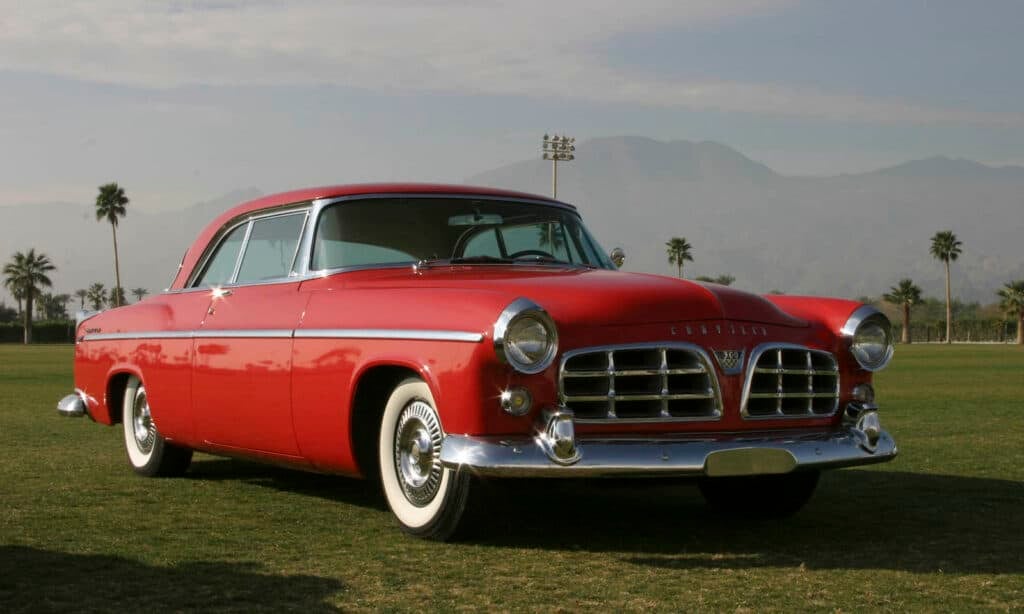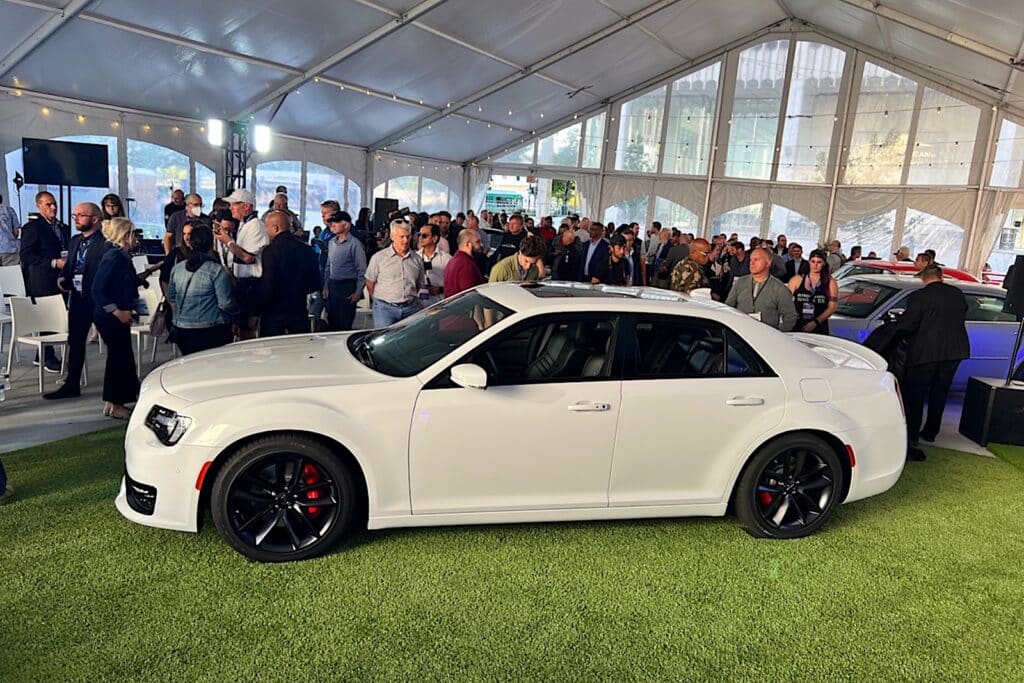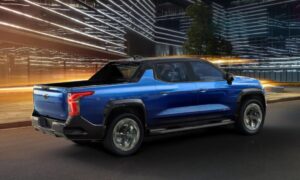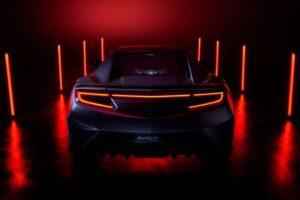This week in 1955, a legacy of luxurious performance arrives in Chrysler introduces the C-300 hardtop coupe, the forerunner of today’s luxury sport sedans such as the Cadillac CTS-V, the BMW M5 and, most importantly, the 2005 Chrysler 300C, which survives relatively unchanged to this day.

But the car itself is far more of an overlooked milestone, one dubbed a beautiful brute by writers of the time.
An engine begets a car
The car’s creation came from Chrysler’s need to find a place for its upgraded 5.4-liter Hemi engine, as there wasn’t a suitable car in the Chrysler stable of vehicles. Vice President of Styling Virgil Exner and his team came up with an economical solution: Create the Chrysler 300 by combining the body of the Chrysler Windsor with the front of a Chrysler Imperial, as there wasn’t enough money to design a new vehicle from scratch.
The car’s name, C-300, came from the fact that it was a Chrysler with a 300-horsepower 5.4-liter Hemi V-8 mated to Chrysler’s 2-speed Power Flite automatic transmission.
But this engine was no ordinary powerplant, as engineers modified it with a full racing solid lifter camshaft, larger dual exhaust, and two 4-barrel carburetors. It was fast for its era, running 0-60 mph in 9.8 seconds. Top speed was an impressive 130 mph. It was the most powerful engine offered since the 1937 Duesenberg SJ and boasted more power than even a Cadillac.
But it was more than speed that made the C-300 so remarkable; it was its suspension, which was firmer to improve handling. Dominating the stock car circuit, it won NASCAR and AAA championships in its model year.

Due to the engine’s radical state of tune, air conditioning was not offered, although power windows and power seats were.
The car was offered in three colors: black, red or platinum with a British tan interior. Advertised as “The New Million Dollar Look,” Chrysler sold 1,725 units in 1955, but only about 260 are thought to survive.
Among the most powerful cars produced that year, it cost $4,110, or $45,687 adjusted for inflation.
What came next
Chrysler’s high-performance letter cars would run through the 1965 Chrysler 300L. The line was joined by non-letter Chrysler 300s in 1962, which replaced the Chrysler Windsor in the line-up, and also filled the hole in the market left by the discontinued DeSoto. In 1969, the name was changed, now being spelled out, and the model was powered by a 350-hp 7.2-liter V-8. The Three-Hundred would run through 1971, after which its name was dropped, although it was used as a trim line on the 1979 Chrysler Cordoba.
With the turn of the century, Chrysler’s letter cars were revived with the arrival of the ninth-generation letter car, the 300M, which wore design boss Tom Gale’s cab-forward design and employed front-wheel drive, the only model that did.
A return to form

But rear-wheel drive would return for the Chrysler 300’s 50th anniversary.
“That was a platform that I fought hard for because I just felt like we needed it to shade those segments and have a meaningful differentiation from our competitors,” said Gale in an exclusive interview.
“I mean, the other guys were all going to do another front-wheel-drive sedan. And that’s what the engineers wanted to do because it’s easier. And I said, ‘What’s your reasoning for not wanting to do it?’ ‘Well, you know they’re heavier.’ I said, ‘Well, get out all of the parts and we’ll weigh them up.’ Then they said, ‘Well, they’re more costly.’ So we built the cars both ways, and OK, there was like a couple hundred dollars more in the rear-wheel-drive platform at the time. But then, I went out, did unbranded research on what the consumers’ impression of the value or the cost of the vehicle was. It always like $5-6,000 more than the anticipated purchase price. Well, that was the clincher.”
Chrysler, now part of DaimlerChrysler, created the 2005 300’s LX platform using a modified 1997 Mercedes E Class, including its transmission.
“They used the whole rear suspension basically, and we did our own front and stuff, but basically the packaging was pretty good and I even made the car taller because I felt it enabled us to package it in a shorter and a different look,” Gale said. “I don’t really disguise the fact that it just higher. It really was interesting and, more importantly, it was a new proportion.”

To many at the time, the car resembled a Bentley. But its affordability made it a fashion statement, with Chrysler going so far as to market a version inspired by Detroit-born menswear designer John Varvatos. The car received a facelift in 2010, and has remained largely unchanged since.
The final chapter
For 2023, the Chrysler 300 is facing its final model year in its current form, although Chrysler will offer a limited-edition Chrysler 300C powered by a 6.4-liter Hemi V8 and that produces 485 horsepower and 475 pound-feet of torque through an eight-speed automatic transmission. That’s enough to propel the 300C to 60 mph in 4.3 seconds. Chrysler plans to limit production to 2,000 units. Rear-wheel drive is standard.
But most 2023 Chrysler 300s will come with a 292-horsepower 3.6-liter V-6 with rear- or all-wheel drive, although buyers can also opt for the rear-wheel-drive 300 S, which comes with a 363-horsepower 5.7-liter V8.
In all, it’s a fitting final chapter to a legendary luxury performance car line.
- SEO Powered Content & PR Distribution. Get Amplified Today.
- Platoblockchain. Web3 Metaverse Intelligence. Knowledge Amplified. Access Here.
- Source: https://www.thedetroitbureau.com/2023/02/the-rearview-mirror-chryslers-beautiful-brutes/
- 000
- 1
- 110
- 1999
- 2023
- 7
- 9
- a
- AAA
- About
- Adjusted
- After
- AIR
- Air Conditioning
- All
- Although
- always
- and
- Anniversary
- Another
- Anticipated
- arrival
- Automatic
- back
- Basically
- beautiful
- because
- behind
- being
- Black
- BMW
- body
- BOSS
- brand
- British
- brought
- built
- buyers
- Cadillac
- car
- cars
- Century
- Chapter
- chrysler
- class
- COM
- combining
- come
- competitors
- Cost
- Couple
- create
- created
- creation
- credit
- Current
- day
- decades
- Design
- Designer
- DID
- different
- Dollar
- dollars
- Dont
- drive
- dropped
- dubbed
- easier
- enabled
- Engine
- Engineers
- enough
- enough money
- Era
- Even
- Exclusive
- Facelift
- facing
- Fashion
- FAST
- filled
- final
- Find
- fitting
- form
- from
- front
- full
- get
- going
- good
- Handling
- Hard
- high-performance
- higher
- history
- Hole
- HTTPS
- idea
- Imperial
- impressive
- improve
- in
- Including
- inflation
- inspired
- interesting
- interior
- Interview
- Introduces
- IT
- itself
- John
- joined
- Know
- largely
- larger
- Legacy
- legendary
- letter
- LIMIT
- limited-edition
- Line
- Long
- Look
- luxurious
- Luxury
- made
- many
- Market
- max-width
- meaningful
- milestone
- million
- Million dollar
- mirror
- model
- modified
- money
- more
- most
- name
- nearly
- Need
- needed
- New
- offer
- offered
- ONE
- ordinary
- Other
- own
- package
- packaging
- part
- parts
- performance
- Place
- plans
- platform
- platinum
- plato
- Plato Data Intelligence
- PlatoData
- power
- powered
- powerful
- president
- pretty
- price
- Produced
- Production
- Propel
- purchase
- racing
- radical
- received
- Red
- relatively
- remained
- remarkable
- replaced
- represented
- research
- return
- reveal
- Run
- running
- Said
- seconds
- sedans
- segments
- since
- So
- so Far
- sold
- solid
- solution
- speed
- Sport
- stable
- standard
- State
- Statement
- stock
- such
- suitable
- survive
- suspension
- team
- The
- thought
- three
- Through
- time
- to
- today’s
- top
- TURN
- units
- upgraded
- us
- value
- vehicle
- Vehicles
- version
- Vice President
- wanted
- wanting
- ways
- week
- weigh
- What
- which
- will
- windows
- Windsor
- Won
- would
- year
- Your
- zephyrnet












